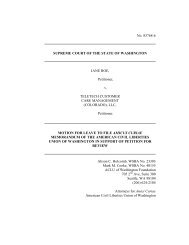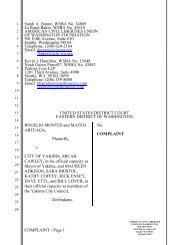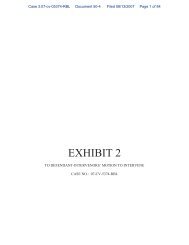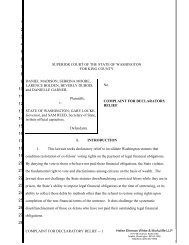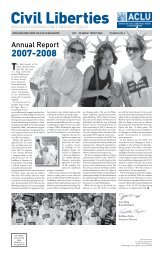BERGER v. CITY OF SEATTLE - ACLU of Washington
BERGER v. CITY OF SEATTLE - ACLU of Washington
BERGER v. CITY OF SEATTLE - ACLU of Washington
Create successful ePaper yourself
Turn your PDF publications into a flip-book with our unique Google optimized e-Paper software.
266 <strong>BERGER</strong> v. <strong>CITY</strong> <strong>OF</strong> <strong>SEATTLE</strong><br />
337 U.S. 1, 4 (1939) (“[A] function <strong>of</strong> free speech under our<br />
system <strong>of</strong> government is to invite dispute. It may indeed best<br />
serve its high purpose when it induces a condition <strong>of</strong> unrest,<br />
creates dissatisfaction with conditions as they are, or even<br />
stirs people to anger.”). The majority’s vision <strong>of</strong> a public park<br />
as a place regulated to protect the placid outings <strong>of</strong> “associating”<br />
citizens who are forbidden to engage in “speech activities”<br />
at all, lest someone be unsettled, is alien to the values<br />
instinct in the First Amendment, and to the entire public<br />
forum concept. Are two people chatting on a street corner in<br />
an “association” that can properly be protected by preventing<br />
a fellow citizen from <strong>of</strong>fering them a handbill? Are picnickers<br />
on the National Mall in <strong>Washington</strong>, D.C., to be so “protected”?<br />
The majority’s reading <strong>of</strong> Dale and Roberts to create<br />
such a sweeping ability to protect “association” vitiates<br />
speech protections in all public fora locations.<br />
Further, even in the abortion clinic context, where speech<br />
restrictions may be somewhat broader, the Supreme Court has<br />
struck down a captive audience rule that bears a marked<br />
resemblance to the one the majority upholds today. In<br />
Schenck, the Court considered an injunction which barred<br />
demonstrations within fifteen feet <strong>of</strong> any person or vehicle<br />
using an abortion clinic, id. at 367, and held that this “floating”<br />
buffer created an uncertain and over-broad system <strong>of</strong><br />
restraints on speech. 519 U.S. at 377-80. As clinic patients<br />
moved, speech-restricted areas shifted across the landscape in<br />
an unpredictable and, in the Court’s view, unacceptable manner.<br />
Id.<br />
The same problems are present here and are not leavened<br />
by the clear public safety issues present in Schenck. The Seattle<br />
Center’s captive audience rule applies within thirty feet <strong>of</strong><br />
any line, any audience, and even any group <strong>of</strong> people having<br />
lunch in a seating area. Crowds move. As the end <strong>of</strong> a line<br />
shifts, or a picnic table is occupied, the captive audience rule<br />
snaps on to bar speech within thirty feet <strong>of</strong> the line or <strong>of</strong> the<br />
picnicking park-goers. This system <strong>of</strong> shifting “speech-free”




